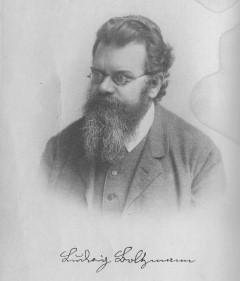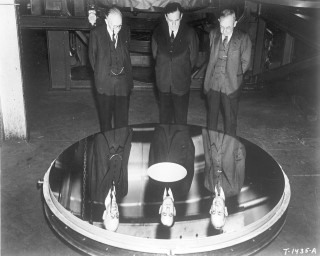Ludwig Boltzmann: In Meyer, S. (1904). Festschrift Ludwig Boltzmann gewidmet zum sechzigsten geburtstage 20. februar 1904: Mit einem portrait, 101 abbildungen im text und 2 tafeln. Leipzig: J. A. Barth.
Credit: Courtesy of The University of Chicago Library
About thirty years after Friedrich Bessel’s death, two Austrian physicists, Stefan and Boltzmann, would simultaneously discover that the luminosity of a hot object depends directly on its temperature. This realization would allow Ejnar Hertzsprung, a Danish astronomer, and Henry Norris Russell, an American astronomer, to connect luminosity to the spectral types of stars thirty years later. The Hertzsprung-Russell diagram would become a seminal tool for astronomers, allowing them to understand more deeply the physical characteristics of stars.
Astronomers mean very specific things when they talk about the spectal type of a star and its luminosity. Spectral types were used to classify the spectra of stars based on the spectral lines found in their spectra. The types were called O, B, A, F, G, K, L, and M. The system is still used today and the order I list them in is an order of decreasing temperature of the atmosphere of the stars. Stars of type O have strong lines of ionized helium but weak lines of hydrogen (H) and are the hottest stars (~30,000 K). Stars of spectral type B show lines of neutral helium and increasing hydrogen line strengths as the stars are cooler (20,000 K to 10,000 K). Stars of type A have very strong lines of hydrogen, no lines of helium and increasing strengths of the lines of ionized calcium (along with other ions) for cooler temperatures (10,000K to 8000K). Later type stars (G, K, M) have increasing strengths of neutral species (such as calcium).
Henry Norris Russell at the McDonald Observatory: McDonald Observatory 82-inch reflector telescope mirror. From left, John S. Plaskett, C. A. Robert Lundin, and Henry Norris Russell.
Credit: University of Chicago Photographic Archive, apf6-01651, Special Collections Research Center, University of Chicago Library
Luminosity is the term used for the total energy flux in radiation that comes from the entire stellar surface every second. Given the temperature (which can be found from the spectral type), and the stellar radius, the luminosity can be calculated from the Stefan-Boltzmann law. But, how much radiation we see on Earth depends on how far away a star is. Identical stars at different distances will appear fainter, the further away they are. The energy per second we perceive to reach Earth from a star is called its apparent luminosity. The true, intrinsic luminosity (from the Stefan-Boltzmann law, for instance), is called the absolute luminosity.



